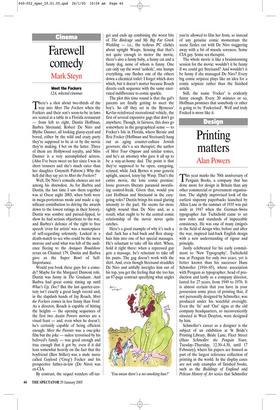Printing matters
Alan Powers
This year marks the 70th anniversary of Penguin Books, a company that has done more for design in Britain than any other commercial or government organisation. The slightly improvised look of the earliest sixpenny paperbacks launched by Allen Lane in the summer of 1935 was put aside in 1947 when the German–Swiss typographer Jan Tschichold came to set new rules and standards of impeccable consistency. He was one of many émigrés in the field of design who, before and after the war, inspired laid-back English design with a new understanding of rigour and principle.
Justly celebrated for his early commitment to ‘New Typography’, Tschichold was at Penguin for only two years, yet is better known than his successor Hans Schmoller (1916–85), whose association with Penguin as typographer, head of production and lastly as a company director, lasted for 27 years, from 1949 to 1976. It is almost certain that you have in your possession some piece of printing that, if not personally designed by Schmoller, was produced under his watchful oversight. Even the ‘In’ and ‘Out’ signs at the old company headquarters, so inconveniently situated in West Drayton, were designed by him.
Schmoller’s career as a designer is the subject of an exhibition at St Bride’s Printing Library, Bride Lane, Fleet Street (Hans Schmoller: the Penguin Years, Tuesday–Thursday, 12.30–4.30, until 17 February), where his papers are housed as part of the largest reference collection of printing in the world. In the display cases are not only examples of finished books, such as the Buildings of England and Pelican History of Art series that Schmoller designed for his fellow émigré Nikolaus Pevsner, but also the corrected proofs and meticulously hand-drawn ‘roughs’ prepared by Schmoller for the typesetters.
Having worked as a young man in a printer’s in Berlin, before coming to London in 1937 to attend a course run by the Monotype Corporation, Schmoller had learnt printing from the ground up in the days of metal type. He escaped his fate as a Jew in Germany by answering an advertisement for a printer in Basutoland, where he developed his self-education and international contacts, despite a quite unnecessary two years of wartime internment. Schmoller took up one of these contacts, with Oliver Simon of the Curwen Press, and returned to London and marriage in 1947. Penguin offered him a wider scope, and he worked long enough to see the arrival of alternative techniques and tastes. Less severe in his taste than Tschichold, he was nonetheless a stickler (known as ‘half-point Schmoller’ because of his ability to spot tiny errors of spacing or dimension).
The exhibition shows, however, that the effort was worthwhile, being guided at all times by consideration for the reader’s comfort and convenience. Even though printing techniques changed during his time, and illustrated covers, initially spurned as American and commercial, began to inch their way on to Penguins before the floodgates burst in the early Sixties, Schmoller retained control of the insides of the books. By the time of The Complete Pelican Shakespeare in 1969, he decided to use photo setting rather than metal type, as the printing was to be done in America. At this date, it was theoretically possible to set type by computer, but this option was rejected as insufficiently ‘hands-on’. This single-volume edition nicely captures Schmoller’s ability to be both tight and jaunty at the same time. He enjoyed the fact that, when Penguin decided they wanted to test the Obscene Publications Act of 1959 by publishing Lady Chatterly’s Lover, he was chosen to deliver 12 copies of the book to a police cadet at Bow Street as a token form of publication (a police constable would not serve for the purpose, being considered ipso facto incorruptible).
Printers and designers have a habit of extra-curricular activity. Schmoller was much involved with the Double Crown Club, a social organisation of printers and designers founded in the 1920s, and he also devised and designed Christmas gift books for presentation by Allen Lane, now avidly sought by collectors for their unusual texts, typography, illustration and binding.
Now that everyone is his or her own typographer at the computer, it is increasingly important to know that design for printing has rules that make life better, and Schmoller’s example serves as a reminder of why they matter.
















































 Previous page
Previous page